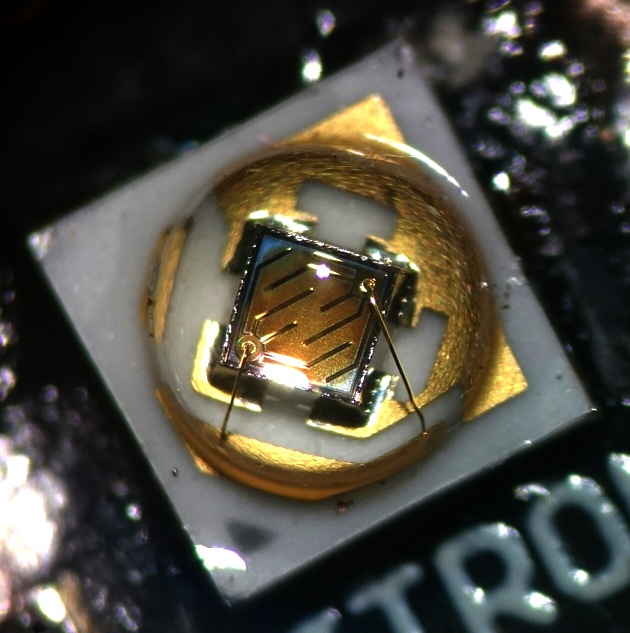
This led was sent to me a month ago by BLF-member led4power for testing, as he considers selling these. I do not know its source other than led4power, and he did not provide much information, I only last week received some specifications, but no datasheet. But I'm interested in any new led  so here we go.
so here we go.
This is what information I got:
Led type: SMD 3535
Led color : Ultraviolet
Chip(die): Semileds
Package size: 3.5×3.5×2.0 mm
Dominant wavelength: 365-370nm
LED Power rating: 1W
Forward current: 350mA
Peak pulsed current: 700mA
Typ. forward voltage: 3.5V
Typ. radiometric output: 410mW
(If=350mA,Tj=25C)
Viewing angle: 120deg
Operating temp. range: -20~+80C
While handling the led I dropped it on the table a few times, so the bit scratched dome on the picture is my fault, the dome was nice and clear upon arrival. It seems the silicone on this led scratches more easily than the usual led.
I have never designed a proper test set-up for UV-leds so I used the same set-up as former UV led tests, but still changed it a bit by adding a ZWB2 filter under the piece of photocopier paper. So the stack of items is now from bottom to top:
cooled ledboardmount -> 16mmNoctigon -> UVled -> reflector -> ZWB2filter -> piece of copier paper -> plastic aspheric lens -> 13.2cm of air -> luxmeter sensor.
For a picture (without ZWB2 filter) see the Nichia NCSU276A test. Adding the ZWB2 filter makes this test not well comparable with my former UV-led tests but I think it is a useful addition because it transmits light close to 365nm better than light closer to 400nm (that would still add to the paper fluorescence). This way, without actually measuring the output spectrum, a led that emits the right wavelength will test better than one that emits a too long wavelength. I promise if I ever will do another UV-led test I will start by designing a really proper test set-up.
I compared the led with the Royalighting RY-3535P 365nm led (sold by intl-outdoor.com and also appears in the Jaxman UV-lights), a test was done last year. For this comparison I used the same led as in last year's test, that led may have suffered a bit from overdriving it (up to 1.9A) for that test. But it was what I got.
Here's the comparison graph, mind that the output unit is abritrary so can only be used to compare these two leds with each other:
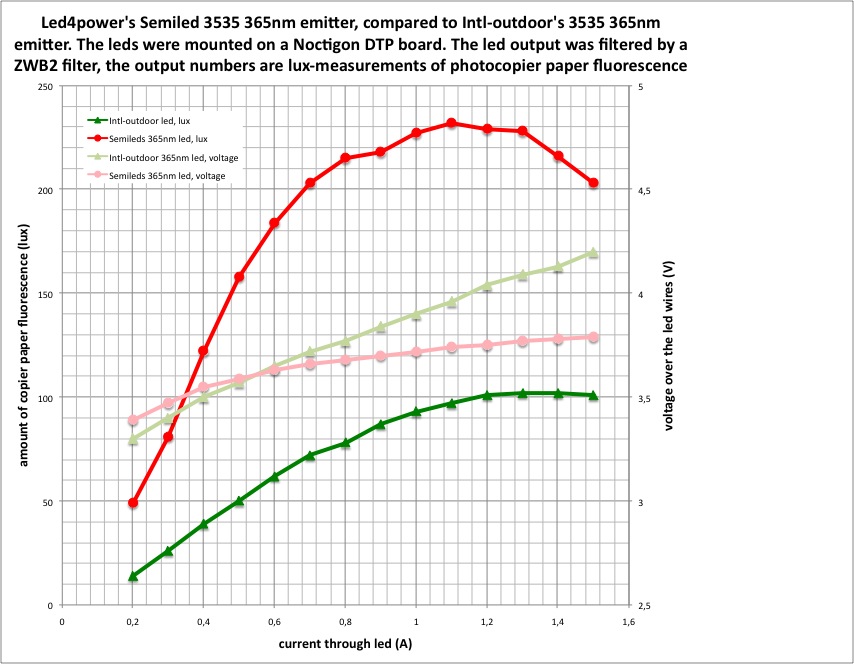
So it appears that this new led has a way better output than the Royalighting led, with at the most useful current (700-800mA) a lower voltage. Even if a fresh Royalighting led was used I'm sure it would be beaten hands down by this Semileds UV-led. I did not do the test without the ZWB2 filter as well, so I don't know which part (if any) of the better output is caused by the led having an output maximum closer to 365nm.
How about the amount of visible light? The led was build into a 602H host at 700mA and I made a series of pictures of my dirty gas cooker to compare what you actually see with the led in a flashlight. The other leds (all at 700mA in a 602H type of host) are Nichia NCSU276A 365 and Royalighting RY-3535P (which is in the above output test as well).
Mind that the relative output of the lights is not seen in the picture because the exposure was not fixed (I wanted to show the quality, not the intensity, there's the graph for that). Mind as well that the visible light compared to fluorescence shows too high in the pictures somehow: in reality I see the fluorescence caused by the UV better than in the pictures.
First the Nichia:

The purple is in real less visible, but there's certainly an amount of visible light present in the Nichia led output, that does noticably interfere with the UV-fluorescence.
Then the Royalighting led:
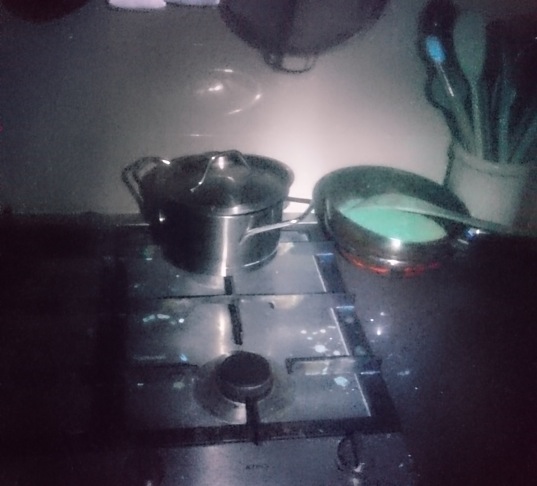
A generous amount of whitish light is visible, obscuring most of the UV-fluorescence
Last the Semileds led:

Also a lot of visible light, a bit more yellowish than the Royalighting led but comparable. What can not be seen is that there's generally much more output in this flashlight, much more than the Nichia flashlight as well.
Now I must make a reservation on the Nichia flashlight: I'm not sure, but it seems that the output has become less than before, with perhaps more visible light even. Roughly estimated from the test I did on this Nichia, the Semileds led should indeed have a bit more output than the Nichia, but when comparing these flashlights, the Semileds led seems to have at least four times as much output and that is unexpected  . Does the Nichia led age fast or did it suffer from the test I did? (the current is still 700mA).
. Does the Nichia led age fast or did it suffer from the test I did? (the current is still 700mA).
Edit: I checked the looks of the Nichia led and it has altered, so I don't trust this led to perform to specs anymore. See post #4
Next was building a new Semileds led (I received two of them from led4power) into a host with a ZWB2 filter filtering out the visible light, and see what happens. Pretty pictures of the flashlight follow, but here's the same kitchen scene with Semileds+ZWB2:
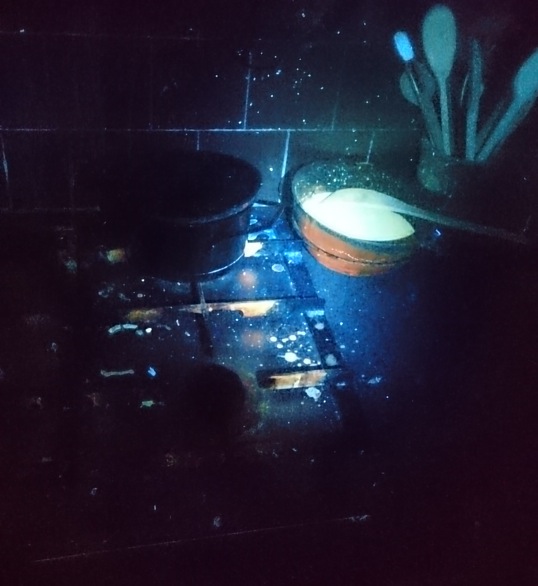
Now that is how a 365nm flashlight should behave, just the clear UV-fluorescence without any disturbing visible light!! This flashlight is stunning, I see stains in my home everywhere I have never seen them before, also not with the Nichia UV flashlight. With this light I can see markings in the wall plaster that show the underlying structure and generally every fingerprint that was ever placed on the wall. I will not give details of what can be seen on the couch and rug  (family with 5yr old son).
(family with 5yr old son).
Some prety pictures now. The host I used was a BLF-A6 (sorry bugsy, I had to dismantle one!), with AK-47 3-modes driver with one chip removed (2 leftover:700mA). I found a clear o-ring with blue fluorescence that fitted the A6 head well. The led is the Semileds 365nm led, the lens is a 2x20mm ZWB2 filter. Last, I did the little-leds tailcap mod, with tiny 405nm UV 1206-size SMD-leds, not much output compared to other colours but the purple suits this flashlight :love:
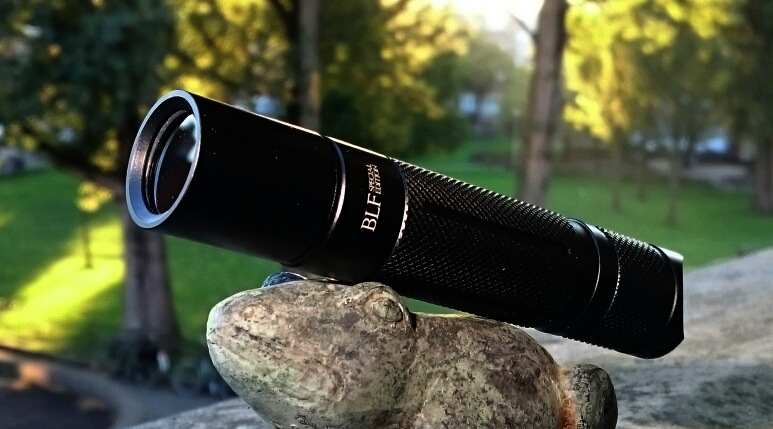

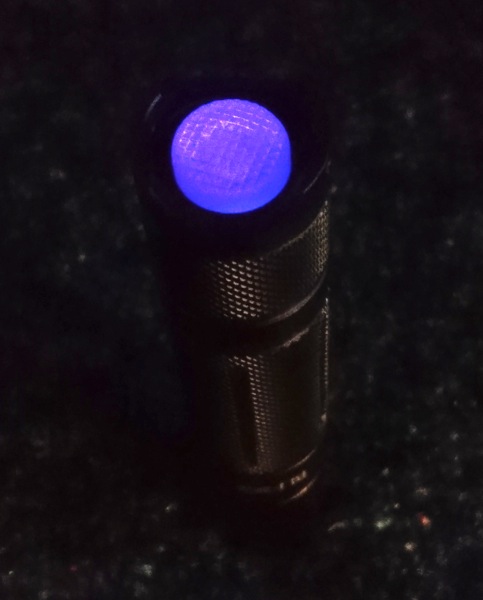
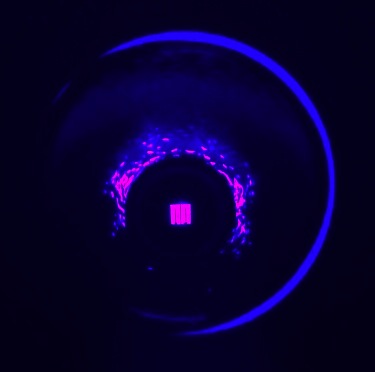
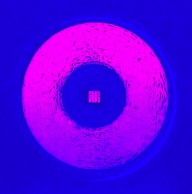
When the tubes are available, this will be a 18350 shorty.
Conclusion: I think this led is a great one, the UV-output is at least close to 365nm and the amount is impressive, more than the Nichia NCSU276A U365, and it comes from a small XP-E size die, so it can throw as well if you like that. The only drawback is the large amount of visible light it puts out as well, like most 365nm leds btw. I solved that by using a UV-pass filter, but these filters cost some money, between 10 and 20 dollars.
Thanks for reading!
note1: I do not know when and for what money led4power is going to sell these, I hope he chimes in here.
note2: this led could be an upgrade for the Jaxman U1 flashlight (this is not meant as a plug for the group buy, I just seriously think it is a good idea)


